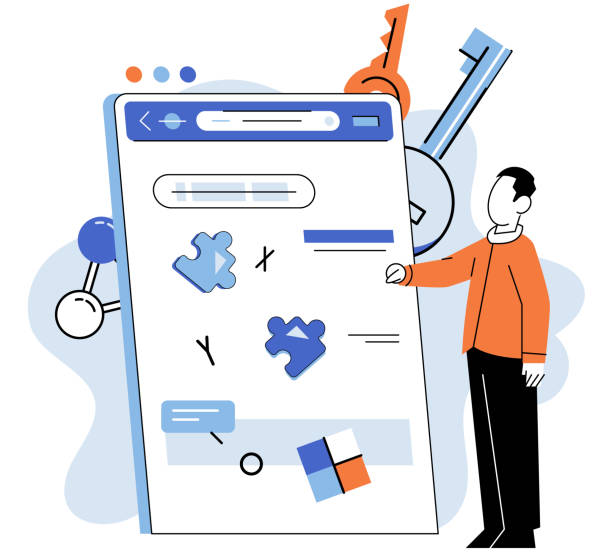Introduction to the Importance of Fast Website Design

In today’s digital world, where every second is vitally important, #website_speed is not just a competitive advantage, but a necessity.
Internet visitors are impatient and expect web pages to load in a fraction of a second.
If your website is slow, users will quickly abandon it and move on to your competitors.
This is especially critical for online businesses and e-commerce stores.
Research has shown that even a one-second delay in page loading can lead to a significant decrease in conversion rates and customer satisfaction.
For this reason, the concept of fast website design is of particular importance.
This not only affects user experience (UX) but also plays a direct role in your site’s ranking in search engines.
Google and other search engines consider loading speed as an important factor in their ranking algorithms.
Therefore, a slow website can severely lower your SEO ranking.
Focusing on optimizing website loading speed is a smart investment for any online business seeking sustainable success in the web space.
In the following sections of this article, we will delve deeper into various aspects of fast website design and provide practical solutions for achieving it.
This is an analytical and explanatory approach to understanding the fundamental need for speed on the web.
Did you know that poor online store design can drive away up to 70% of your potential customers? Rasaweb transforms your sales with professional and user-friendly e-commerce website designs.
✅ Significant increase in sales and revenue
✅ Full optimization for search engines and mobile
⚡ [Get Free Consultation from Rasaweb]
Key Factors Affecting Website Speed

To achieve a high-speed website, you must first identify the main factors that influence its loading time.
These factors can be very diverse, from technical infrastructure to coding details and visual content.
One of the most important factors is the quality of the #hosting service.
Cheap shared hosting may save costs, but it often lacks sufficient resources to handle high traffic and provide adequate speed.
Choosing a dedicated hosting or VPS with high quality is the first important step to improve speed.
The next factor is the size and optimization of images and videos.
Large-sized images and uncompressed formats can place a heavy load on the server and user bandwidth.
Using optimized images, proper compression, and modern formats like WebP significantly impacts fast website design.
Additionally, unoptimized and bulky JavaScript and CSS codes can delay page rendering time.
Minifying and concatenating these files, as well as deferring the loading of non-essential resources, are fundamental techniques in this area.
Using content management systems (CMS) like WordPress with heavy themes and plugins can also reduce site speed.
Choosing lightweight themes and essential, optimized plugins is crucial for fast website design.
Understanding these key factors and addressing each of them individually paves the way for significant website performance improvement.
This section has an educational and specialized approach.
Optimizing Images and Media for Faster Speed

One of the biggest obstacles to fast website design is large images and media.
These files can constitute a significant portion of the total page size and severely increase loading time.
The first step in optimization is choosing the appropriate format.
For images with high detail and diverse colors, JPEG is usually a good option, while for logos, icons, and transparent images, PNG is better.
However, more modern formats like WebP offer better compression while maintaining quality and should be prioritized.
After selecting the format, compressing images without a noticeable loss of quality is very important.
Various online tools and software are available for this purpose that can significantly reduce file size.
Also, using appropriate image dimensions for web display is highly important.
Loading a 4000-pixel image to display in a 400-pixel space is a waste of bandwidth and time.
The Lazy Loading technique is also an excellent solution for improving initial load speed.
With this method, images and videos are loaded only when the user scrolls to the relevant section, not immediately upon entering the page.
This has a significant impact on fast website design, especially for long pages with a lot of visual content.
For example, an image gallery can dramatically speed up page loading with this method.
These solutions are provided as guidance and specialized advice and directly contribute to achieving a high-speed website.
| Optimization Method | Description | Impact on Speed |
|---|---|---|
| Lossless Compression | Reduces image file size without noticeable visual quality loss. | Reduces image download time, faster loading. |
| Using WebP Format | Modern format with higher compression than JPEG/PNG. | Smaller file size, much faster loading. |
| Lazy Loading | Loading images only when needed (user scroll). | Improves initial page load speed. |
| Appropriate Image Dimensions | Image sizes proportionate to their display space on the web. | Reduces loading of unnecessary data. |
Choosing the Right Host and Infrastructure for Optimal Performance

Choosing the right infrastructure and #hosting service is the cornerstone of any successful strategy in fast website design.
As mentioned earlier, cheap shared hosting may seem attractive at first, but resource limitations and sharing with dozens or hundreds of other websites often lead to reduced speed and poor performance.
To achieve high speed, more advanced options such as VPS (Virtual Private Server) hosting or dedicated servers are recommended.
These options provide you with more resources and offer more complete control over the server environment.
In addition to the type of host, the geographical location of the server is also very important.
If the majority of your audience is in Iran, choosing a server located in Iran or nearby countries can significantly reduce latency and, consequently, contribute to fast website design.
Using modern technologies such as #SSD (Solid State Drives) instead of HDD (Hard Disk Drives) in servers increases data read and write speeds several times over and accelerates file loading.
Another vital component in web infrastructure is the use of a CDN (Content Delivery Network).
A CDN stores your website’s static content (such as images, CSS, and JavaScript) on multiple servers worldwide, and when a user visits your site, the content is delivered from the server closest to them.
This specialized and guiding approach will guarantee the stability and high speed of your website.
Does your current website convert visitors into customers, or does it drive them away? With professional corporate website design by Rasaweb, solve this problem forever!
✅ Building strong credibility and branding
✅ Attracting target customers and increasing sales
⚡ Get a free consultation now!
Clean Coding and Database Optimization

Beyond infrastructure and images, the website’s own coding plays a fundamental role in fast website design.
Clean and optimized code not only makes readability and maintenance easier but also allows the browser to render the page faster and more efficiently.
One of the main methods is Minification of CSS, JavaScript, and HTML files.
This process involves removing unnecessary characters such as spaces, blank lines, and comments from the code, which reduces file size and speeds up their download time.
Additionally, Concatenation, which means combining multiple CSS files into one and multiple JavaScript files into one, is important.
This reduces the number of HTTP requests to the server, which is a significant factor in increasing speed.
In addition to the code, the website’s database must also be optimized.
Heavy and unoptimized databases can severely increase server response time.
Using indexes for frequently used queries, deleting old and unused data, and optimizing table structure are among the fundamental solutions for increasing database speed.
For example, in WordPress, regularly deleting old post revisions and optimizing database tables can have a significant impact on speed.
Also, using server-side Caching systems (such as Redis or Memcached) to store database query results can drastically reduce server load and greatly contribute to fast website design.
This section takes an educational and specialized approach to software architecture.
The Role of CDN and Caching in Fast Website Design

To achieve a fast website design and stable performance, the use of two key concepts: CDN (Content Delivery Network) and Caching is essential.
CDN stands for “Content Delivery Network,” and as its name suggests, it stores your website’s static content (such as images, CSS, and JavaScript files) on servers distributed across various geographical locations worldwide.
When a user from a specific region visits your website, this content is delivered to them from the closest CDN server, not from your website’s original server.
This significantly reduces latency and improves the user experience, especially for users accessing your site from long distances.
Caching is also a process where temporary copies of website content (pages, images, data) are stored in a hidden memory so that during subsequent visits, there is no need to reload them from the server.
This caching can occur at different levels: Browser Caching, which stores content on the user’s device; Server-Side Caching, which stores content in server memory for faster responses; and Database Caching, which stores database query results.
Combining these two strategies, namely CDN and Caching, can have a tremendous impact on website loading speed and stability and make fast website design a reality.
This section is explanatory and specialized.
Website Speed Test Tools and Results Analysis

After implementing various solutions for fast website design, it’s important to regularly measure and analyze your website’s performance.
Website speed test tools provide valuable insights into your site’s strengths and weaknesses regarding speed.
Google PageSpeed Insights is one of the most widely used tools available, which not only provides a score for your site’s speed on mobile and desktop but also offers specific recommendations for performance improvement.
These recommendations include image optimization, reducing server response time, eliminating render-blocking resources, and more.
Other tools like GTmetrix and Pingdom Tools also provide comprehensive and detailed information, including a Waterfall Chart, which shows how long each page element (images, CSS, JS) takes to load.
Analyzing these charts helps you identify your site’s bottlenecks.
For example, if you observe that a particular JavaScript file takes a long time to load, you can prioritize its optimization.
Additionally, these tools measure important metrics such as First Contentful Paint and Largest Contentful Paint, which directly impact user experience.
Regular monitoring and implementing the recommendations from these tools are an integral part of the continuous process of fast website design and maintaining a high-performance website.
This guiding and analytical approach helps you on the path of continuous improvement.
| Tool Name | Key Features | Highlights |
|---|---|---|
| Google PageSpeed Insights | Mobile and desktop performance scores, improvement recommendations, Core Web Vitals. | Real-world and simulated data, relevant to Google SEO. |
| GTmetrix | Comprehensive reports, waterfall chart, performance display with YSlow and PageSpeed Score metrics. | Detailed technical information for developers. |
| Pingdom Tools | Speed test from different geographical locations, detailed loading report for each element. | Easy analysis for non-technical users. |
Impact of Site Speed on User Experience and SEO

Website speed is not just a technical indicator; it directly affects two critical aspects of your online success: User Experience (UX) and Search Engine Optimization (SEO).
From a user experience perspective, a slow website can be very frustrating.
Modern users expect pages to load quickly, and if they don’t, they are highly likely to leave your site.
This leads to an increase in Bounce Rate; that is, the percentage of users who leave your site after viewing only one page.
A high bounce rate indicates user dissatisfaction and can be a negative signal for search engines.
Conversely, fast website design encourages users to stay on your site longer, view more pages, and engage with your content.
This leads to improved conversion rates, increased sales, and customer loyalty.
From an SEO perspective, Google and other search engines have explicitly stated that page loading speed is a ranking factor.
Faster websites achieve better rankings in search results.
Additionally, Google’s Core Web Vitals metrics, which include loading speed, interactivity, and visual stability, directly impact site SEO.
Slow websites may not meet these criteria and, as a result, may rank lower.
Can a business truly survive in today’s competitive landscape without addressing these two vital factors? The answer is definitely no.
Fast website design is an investment in your business’s future.
This section takes an analytical and thought-provoking approach to content.
Are you losing business opportunities because of an outdated website? With Rasaweb, forever solve the problem of not attracting potential customers through your website!
✅ Attracting more high-quality leads
✅ Increasing brand credibility in the eyes of customers
⚡ Get free corporate website design consultation
Advanced Strategies for Achieving Maximum Speed

For those looking to go beyond standard optimizations and achieve the highest level of speed in fast website design, there are more advanced strategies.
One such strategy is the use of AMP (Accelerated Mobile Pages).
AMP is an open-source framework designed to create extremely fast web pages on mobile devices.
AMP pages, by removing heavy elements and using optimized code, load almost instantly and provide an unparalleled user experience on mobile.
However, implementing AMP requires attention to specific details and may not be suitable for all types of websites.
Another is PWA (Progressive Web Apps), which combines the best features of web and native applications to provide an app-like user experience in the browser.
PWAs can work offline, have Push Notifications, and achieve high speeds.
This technology can significantly increase user return rates and engagement.
Critical CSS optimization is also an advanced technique where only the CSS needed to render the above-the-fold portion of the page is inlined in the HTML.
This allows the user to see the main content of the page faster, while the rest of the CSS loads Asynchronously.
These approaches require deeper technical knowledge but can elevate your website’s speed beyond competitors and deliver a truly fast website design.
This section is educational and specialized.
Security and Speed; An Essential Balance in Web Development

While focusing on fast website design is very important, the importance of website security should not be overlooked.
In fact, security and speed are two sides of the same coin and must be considered together.
A super-fast website that is weak in terms of security can easily be subjected to cyberattacks, jeopardize user information, and tarnish your business’s reputation.
This not only leads to a loss of customer trust but can also result in heavy penalties and a loss of SEO ranking.
On the other hand, implementing excessive and inefficient security measures can also negatively impact site speed.
For example, using unsuitable web firewalls (WAF) or heavy security plugins may increase server response time.
Therefore, finding the right balance between security and speed is crucial.
Using the HTTPS protocol (SSL/TLS) is essential, which not only encrypts data but can also indirectly help with speed, especially with newer protocols like HTTP/2 that require HTTPS.
Also, optimizing security scripts and ensuring all plugins, themes, and the CMS core are up-to-date helps maintain security without compromising speed.
A secure website, even if slightly slower, is better than a fast but insecure one.
However, the ultimate goal is to achieve both a fast and secure website, which requires a comprehensive and analytical approach.
This section is explanatory and specialized.
Frequently Asked Questions
| Question | Answer |
|---|---|
| What is fast website design? | It refers to the process of building a website with high loading speed and optimized for excellent performance. |
| Why is website speed important? | Website speed directly impacts user experience, conversion rates, SEO, and search engine rankings. |
| What are the factors affecting website speed? | Image size, optimized coding, use of CDN, caching, choosing the right host, and the number of plugins. |
| How can website loading speed be increased? | By optimizing images, compressing files (CSS, JS, HTML), using browser caching, reducing redirects, and using a CDN. |
| What is CDN and how does it help website speed? | Content Delivery Network (CDN) stores your site’s content on various geographical servers and delivers it from the closest server to the user. |
| What is the role of hosting in website speed? | The quality and type of hosting (shared, VPS, dedicated) significantly impact server response time and, consequently, site loading speed. |
| Does using too many plugins reduce website speed? | Yes, each plugin loads additional code which can lead to site slowness. Choosing optimized and essential plugins is recommended. |
| How to optimize images for increased website speed? | Compressing images without losing quality, using modern formats (WebP), setting correct dimensions, and Lazy Loading. |
| How does Caching help website speed? | Caching helps store temporary website content in the user’s browser or on the server so that the site loads faster on subsequent visits. |
| What are the best tools to check website speed? | Google PageSpeed Insights, GTmetrix, and Pingdom Tools are among the common and useful tools for analyzing and improving website speed. |
And other advertising agency services by Rasaweb in the field of advertising
Tips for selecting ad size for display on industrial websites
How to simplify ads for beginner audiences?
Using big data to improve home appliance ads
Ways to increase conversion rates in home appliance ads
How to use music in home appliance ads?
And over hundreds of other services in the field of online advertising, advertising consultation, and organizational solutions
Online Advertising | Advertising Strategy | Advertorials
💡 For a significant leap in the digital world and to reach the peak of success, Rasaweb Afarin Digital Marketing Agency smooths the path for your business growth by offering comprehensive services including multilingual website design, professional SEO, social media management, and targeted advertising campaigns.
📍 Tehran, Mirdamad Street, next to Bank Markazi, Southern Kazeroon Alley, Ramin Alley, No. 6

